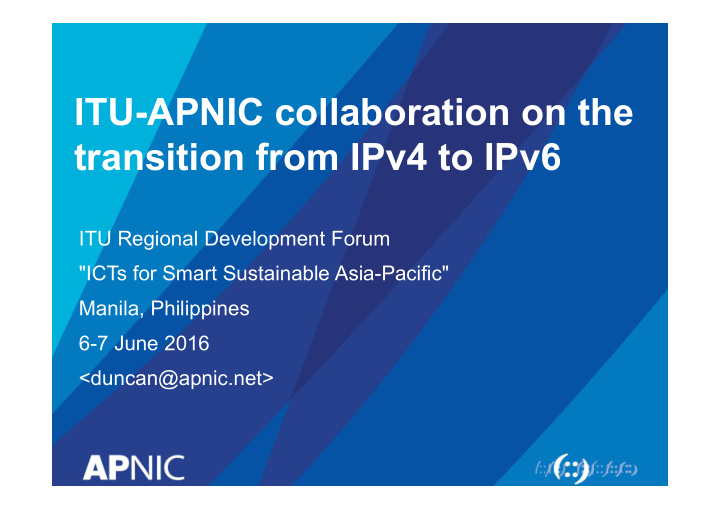



ITU-APNIC collaboration on the transition from IPv4 to IPv6 ITU Regional Development Forum "ICTs for Smart Sustainable Asia-Pacific" Manila, Philippines 6-7 June 2016 <duncan@apnic.net>
Agenda • Introduction • ICT growth and economic development • Scalable growth of IP-based services and IPv6 • Collaboration between ITU and APNIC • IPv6 capacity development • Way forward – APNIC Development Program
APNIC • Primary function: Distribution and “A global, open, management of Internet number resources stable, and – IPv4 and IPv6 addresses secure Internet – Autonomous System Numbers (ASNs) that serves the • Not-for-profit, membership organization entire Asia – 5,000+ Members (10,000+ Members Pacific in total) community” • How we achieve APNIC’s vision: – Technical training and assistance – Support for community development (NOGs, CERTs etc.) – Supporting infrastructure development • IPv6, IXPs, root server deployment 3
Securing scalable growth of IP-based services • The Internet is a global system of interconnected networks • The most prominent component of the Internet is the Internet Protocol (IP) – IP addresses are unique and essential numbers required to identify the source and destination of digital packets – Vast supply and management of IP addresses is the key in supporting future growth – IP version 6 (IPv6) needs to be widely deployed to secure future growth of the Internet 4
IPv6 capacity development • 20 plus years of APNIC training – Hundreds of IPv6 training courses delivered for APNIC members and the wider community • About 4000 people participate in APNIC trainings annually • Collaboration with the ITU – APNIC – ITU Asia Pacific (ASP) Centre of Excellence – Training network operators, policy makers and regulators from developing AP economies on IPv6 deployment – IPv6 migration strategies for telecom service providers (2011, 2012) – IPv6 infrastructure network security (2013, 2014, 2015, 2016) – ITU country direct engineering assistance in Lao PDR (2014), Mongolia (2015) and Cambodia (2016)
Collaboration with ITU • Our focus is on IPv6 capacity development in developing economies – Together we educate key network engineers and technical staff from various economies in the Asia Pacific • Supported by: – Ministry of Information and Communication Technology, Thailand – ToT Academy, Thailand • To deliver hands-on practical training courses and direct engineering assistance to support smooth IPv6 adoption in developing economies 6
Collaboration with ITU IPv6 infrastructure network security workshop • Held in Bangkok, Thailand in May • 5 days; hands-on workshop • 42 participants from 10 economies in the Asia Pacific • Topics – IPv6 protocol, IPv6 addressing, configuration of IPv4 and IPv6 networks, Hardening IPv6 network devices, IPv6 transition technologies, Securing transition technologies, lots of hands-on labs 7
Collaboration with ITU ITU Country Direct Engineering Assistance (EA) • On IPv6 • Held in Ulaanbaatar, Mongolia in July 2015 • 3 days; hands-on workshop (48 participants) + EA at 3 organizations • Individual EA on how to deploy IPv6 in Next collaboration: Cambodia June 20- each networks 23 2016 8
Global IPv6 users (Google) 11% in April 2016
Global IPv6 capability (APNIC) 5.5% in April 2016
Major ISPs – Examples CC ASN AS Name Capable BE AS6848 TELENET-AS Telenet N.V. 70.73% BE AS12392 ASBRUTELE Brutele SC 70.59% US AS7922 COMCAST-7922 - Comcast Cable 60.01% US AS7018 ATT-INTERNET4 - ATT Services, Inc. 78.04% US AS22394 CELLCO - Verizon Wireless 89.88% US AS21928 T-MOBILE-AS21928 - T-Mobile USA, Inc. 45.36% AU AS1221 ASN-TELSTRA Telstra Pty Ltd 8.52%
Why are we waiting…? Some frequent answers… • We have more IPv4 addresses than we need • We have more IPv4 addresses than people! • Our content is offshore, in the cloud, etc. • IPv4 works well enough Ok, but things are changing….
Drivers: network access Without IPv6 (IPv4 only) – New deployments must use NAT (eg mobile) – Carrier Grade NAT is expensive – Increasing costs: x users x bandwidth With IPv6 (dual stack) – Addresses for every device – Offload traffic from NATs – Competitive advantage – IPv4 is eventually irrelevant, no more NAT – LTE can use IPv6 immediately – Also: “Internet of Things”
Drivers: content and services Without IPv6 (IPv4 only) – Degrading customer/client experience – Mobile users at particular disadvantage (all NAT) With IPv6 (dual stack) – Direct connection to all customers – Best performance for all – Better user experience, competitive advantage (esp mobile)
Australia 24,244,056 people 21,068,084 users 87% penetration 1,941 ASes IPv4 IPv6 48,613,120 addresses 3.44% capability 2.01 per head 37,735,639 M addresses 87% visible 1,556,490 per head 47% visible
China 1,381,842,009 people 692,302,846 users 50% penetration 1,273 ASes IPv4 IPv6 337,457,152 addresses 89,154,932 M addresses 0.24 per head 64,518 per head 88% visible 1% visible
17
Korea 50,487,786 people 46,600,226 users 92% penetration 1,019 ASes 0.00 GDP IPv4 IPv6 112,411,136 addresses 22,535,693 M addresses 2.23 per head 446,359 per head 94% visible 0% visible
Philippines 102,131,172 people 43,916,403 users 43% penetration 357 ASes 284.74B GDP IPv4 IPv6 5,445,376 addresses 244,814 M addresses 0.05 per head 2,397 per head 91% visible 11% visible
Singapore 5,689,390 people 4,665,299 users 82% penetration 425 ASes IPv4 IPv6 6,290,944 addresses 794,576 M addresses 1.11 per head 139,659 per head 85% visible 12% visible
APNIC Development Program Capacity building • Face-to-face workshops • Virtual lab • eLearning • Fellowships Technical Assistance • IPv6 deployment planning (e.g. ASEAN) • IXP operation and support • Routing architecture
You’re Invited! 29 September to 6 October https://conference.apnic.net Coming training events 21-24 June IPv6 Infrastructure workshop (ITU) Phnom Penh, Cambodia 4-8 July – PACNOG 19, Port Moresby, Papua New Guinea 19-22 July DNSSEC workshop with ICANN Hanoi, Vietnam 25-27 July Advanced Routing workshop Jakarta, Indonesia https://training.apnic.net 22
Recommend
More recommend